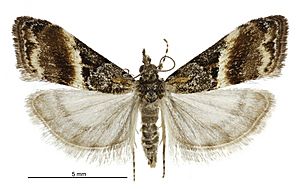Eudonia chlamydota facts for kids
Quick facts for kids Eudonia chlamydota |
|
|---|---|
 |
|
| Scientific classification | |
| Kingdom: | |
| Phylum: | |
| Class: | |
| Order: | |
| Family: | |
| Genus: |
Eudonia
|
| Species: |
E. chlamydota
|
| Binomial name | |
| Eudonia chlamydota (Meyrick, 1884)
|
|
| Synonyms | |
|
|
The Eudonia chlamydota is a small, interesting moth that belongs to the Crambidae family. It was first officially named by a scientist named Edward Meyrick in 1884. This special moth is found only in New Zealand, meaning it is endemic to that country.
Contents
Meet the Eudonia chlamydota Moth
This moth is quite small, with a wingspan (the distance from one wingtip to the other when the wings are spread out) of about 13 to 14 millimeters. That's roughly half an inch!
What Does It Look Like?
The front wings, called forewings, have a light, creamy-white color. However, the part closest to the moth's body is often covered in a dark, blackish shade. This gives the moth a unique pattern.
The back wings, or hindwings, are mostly whitish. But if you look closely, you might see faint grey lines or smudges near the tips and across the middle. These subtle markings help it blend into its surroundings.
When Can You See Them?
Adult Eudonia chlamydota moths have been seen flying around in January. This suggests that January might be their main active period for flying and finding mates.
Where Does This Moth Live?
Since the Eudonia chlamydota is endemic to New Zealand, it means it naturally lives nowhere else in the world. New Zealand is a country known for its unique plants and animals, many of which are found only there. This moth is one of those special creatures.
Why Are Moths Important?
Moths, like the Eudonia chlamydota, play an important role in nature. They can be pollinators, helping plants reproduce by carrying pollen from one flower to another. They also serve as a food source for other animals, like birds and bats, making them a key part of the food chain.

